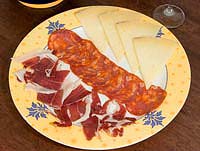

Chorizo is undoubtedly one of the most famous of cured pork sausages. They're porky, spicy, garlicky, mild, hot, smokey and red - all rolled into one!
 No matter what you may desire, you get it all with Chorizos! These unique sausages have been produced and enjoyed for centuries.
No matter what you may desire, you get it all with Chorizos! These unique sausages have been produced and enjoyed for centuries.
From their humble peasant origins to the mechanised production methods of today, chorizos have essentially remained unchanged over this time.
Although there is a whole range of charcuterie products to suit all tastes (see below) chorizos account for about 40% of all Spain’s annual sausage production.
That’s about 65,000 tonnes - a whole lotta sausages!
Chorizo (pronounced choritho) is a dry-cured pork sausage most commonly flavoured with garlic and pimenton (paprika) which gives it its characteristic red colour and smokey flavour.
Sizes, ingredients and flavours vary from region to region and they can also be flavoured with many other herbs and spices. They can be smoked and/or spicy-hot (picante) and they can range in colour from bright orange to dark brown.
Chorizos are sold either whole, in cut lengths or sliced. As it is a dry-cured product it can be eaten uncooked, just slice it and eat it as tapas. Or you can cook it and add its distinct flavour to many dishes.
As with jamón, the quality of charcuterie products depend on the pig it comes from. Most chorizos come from the white pigs but the best (and most expensive) ones, as one would expect, come from the Iberian pig.
They are generally red and are made from chopped pork seasoned with paprika, garlic, herbs and salt. The oils from the pimenton (paprika) and the salt also help to preserve the meat. The sausages are dry-cured in a cool environment.
No contest! As I said above, the best sausages come from the Iberian pig and are known as Chorizo Ibérico. These are rich, fatty and have the unique, acorn-flavoured sweetness as found in the best Iberian hams.
Chorizo Ibérico is unique to Spain and is only produced in small quantities, it is rare, very special and reassuringly expensive! My advice is: if ever you come across it, don’t look at the price tag, just buy it!
Get some delivered to your home, pour yourself a glass of sherry and enjoy another one of life’s rich and rare taste sensations.
There are as many regional variations of the chorizo as there are actual regions of Spain.
The dark red chorizos of Leon and the northern Atlantic regions have a smokey garlic flavour, the chorizos from the Pyrenees and central Spain have a smoked paprika flavour, and the chorizos from the southern Mediterranean areas are garlicky again but with more herbs and hot spices.
Chorizos vary in size from big fat curly ones, to medium u-shaped ones, to skinny straight ones. And just about every combination of the above! The size of them is usually governed by the coarseness of the chopped meat.
Coming a close second to the serrano hams is Lomo Embuchado. This is a whole pork loin, fat removed, marinated and coated with paprika and other spices, then dry-cured. It is just tender lean meat with a fraction of the fat of sausages and a lovely smokey flavour. Just slice it and eat it uncooked.
Salchichones are sausages more like salami and are lean pork mixed with very coarse black pepper instead of paprika. They are generally milder than chorizo and don’t have the red colour.
Morcillas are blood sausages made with nutmeg, onion, pepper or paprika. They are dark red to black in colour. These generally have to be cooked before eating.
Sausages like the lumpy Morcon are full of big chunks of pork mixed with garlic, herbs and paprika.